Rewriting the Script: Independent Pharmacy Trends
2022 Research Report
Pharmacies are in flux.
The industry currently faces numerous headwinds, but there is no better time for independent pharmacists to evolve to best meet their patients’ needs and seize the opportunities brought by change.
Consider these forces: Pharmacies are seeing renewed respect from consumers after they played critical roles during the COVID-19 pandemic; pharmacies of all sizes are feeling the impact of high fees from cash discount cards; and independent pharmacies must set themselves apart amid fierce competition.
Despite some headwinds, pharmacies are well positioned for growth. Within the next decade, a physician shortage and aging population means that the demand for healthcare services will outpace supply.¹ Already, 25% of American adults do not have a primary care provider,² yet nearly half of all adults take a prescription medication at least once a month.³
At Prescryptive Health, we understand independent pharmacies are core to a patient’s experience within the healthcare system. Preserving and strengthening our nation’s independent pharmacies is our passion, and we know technology has the potential to help independent pharmacies not only survive but thrive.
We connect consumers directly to pharmacies and help those pharmacies improve profitability while offering competitive prices and convenient services. Consumers need modern solutions now more than ever as they struggle amid sky-high inflation, unpredictable healthcare costs, and fears of a recession. To gain more insights into the landscape today, we commissioned a survey of more than 340 decision-makers at independent pharmacies and more than 1,000 consumers throughout the United States.
THREE KEY THEMES EMERGED:
- The prominence of consumerism and a growing role for technology in pharmacy
- The cash-paying conundrum consumers and pharmacies face for prescription drugs
- Struggles and opportunities for the future of pharmacy
These results show tremendous changes on the horizon, and they continue to reinforce why Prescryptive Health exists. We help independent pharmacies remain strong, adaptable, and indispensable to the people they serve, both now and in the future.
Consumerism and technology’s growing roles in pharmacy
With rising healthcare costs, consumers are finding ways to save—that includes shopping around when filling their prescriptions. These patients have good reason, as 83% of consumers say the cost of prescription drugs is unreasonable, and one in three has not taken medication as prescribed due to cost.4 Worse, almost one-third of Americans have avoided seeking healthcare due to cost alone, increasing the risk of worsening health outcomes— and downstream costs.
Results from our survey provide new insights into what consumers value in their pharmacies, how consumers view the role of shopping in pharmacies, and how pharmacists view these trends.
Overall, consumers want to have more control over their prescriptions. Technological innovation could provide them with that control.
In fact, 95% of consumer respondents said they were at least somewhat aware that the same medication can be priced differently between pharmacies, while 72% said they would be likely to use their mobile phone to compare drug prices and “shop around.”
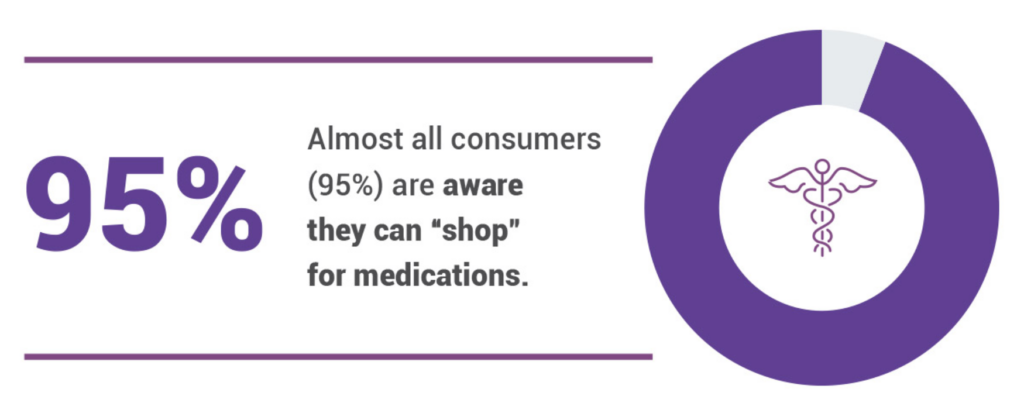
Pharmacists are already viewing these shifting tides as inevitable: 96% of pharmacy decision makers say consumer prescription “shopping” will stay over the next 1-2 years, and 85% think “shopping” will increase in that timeframe. There is also general support for “shopping” among decision makers, with 74% saying they appreciate consumers’ ability to compare prices between pharmacies.
Consumers overwhelmingly see the benefits of a simpler, more transparent medication shopping experience:
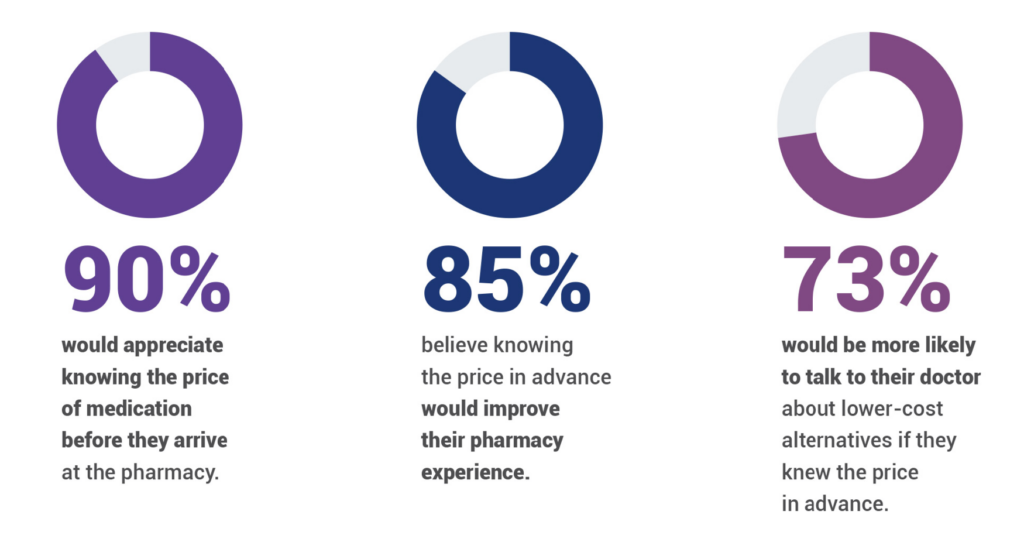
A more approachable shopping process could also lead to improved patient health and financial outcomes. Nearly three-quarters of consumers (73%) said they would be more likely to talk to their doctor about lower-cost alternatives if they knew the cost of drugs before getting to the pharmacy counter. Empowering discussions at the point of prescribing versus the point of dispensing could help patients become more adherent to their medications, especially when cost is a concern.
Our findings show that not only are a large majority of consumers hungry to shop—especially with mobile devices—but that the ability to do so will help retain business. Nearly half (47%) of consumers rated “technology” and “modern communications” as top requirements for retaining their business in the next two years— even more important than “being the lowest cost” pharmacy.
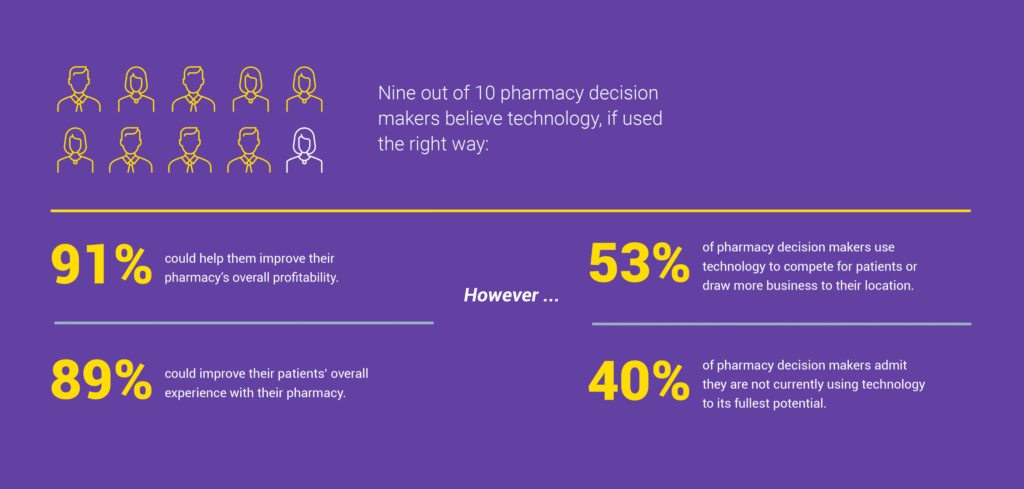
When asked for the top three things that sets their independent pharmacy apart, 69% of consumers said convenience, 64% said customer service, and 38% said knowledge—all of which can be enhanced by a digital platform.
Independent pharmacy decision-makers see the rising need for convenience and expertise, and they recognize technology can help maintain and exceed their existing standards while driving profitability. Nine out of 10 pharmacy decision makers believe technology, if used the right way, could help them improve their pharmacy’s overall profitability (91%) and improve their patients’ overall experience with their pharmacy (89%).
However, there remains a significant gap between those pharmacy decision makers who recognize the trends and those who feel they actually meet customers’ evolving needs. Just 53% of pharmacy decision makers use technology to compete for patients or draw more business to their location, and 40% of pharmacy decision makers admit they are not currently using technology to its fullest potential. This creates a significant opportunity for the many pharmacies that have yet to fully embrace technology.
Consumers indicate a desire to have a higher level of prescription power and control—driven and delivered by technology—so it will be up to pharmacies to adapt.
The cash-paying conundrum
In 2021, nearly 10% of prescriptions were paid with cash discount programs— up from 6% in 2016—and half of those payments were made with discount cards.6
While drug discount cards enable consumer savings, many patients are unaware of the high pharmacy fees frequently associated with such discount programs. Some pharmacy decision makers have had enough of the exorbitant fees, lack of reimbursement, and clawback practices from many popular discount card brands.
Many pharmacy decision makers refuse to even accept certain popular discount cards, while others are forced to honor certain drug discount cards due to contracts with the pharmacy benefit manager (PBM).
Of the decision makers who do not accept drug discount cards, one respondent said, “The fee to process discount cards coupled with the low copay rate leads to a financial loss for the pharmacy the majority of the time.” Another explained, “Our prices are usually cheaper than the prices they offer, and we are not willing to pay any cost associated with them or subject our customers to their data mining.”
We found that an incredible amount of consumers, insured or not, have paid out of pocket for prescriptions in the past year. That includes 31% of respondents who primarily pay out of pocket and 61% of insured individuals who have paid in cash despite having insurance.
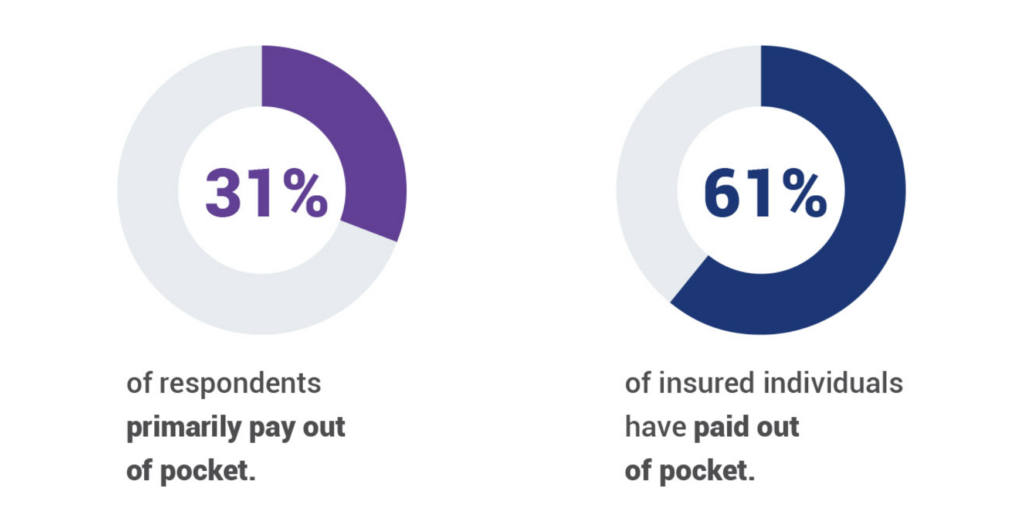
For insured individuals who paid out of pocket, 30% said their medication was less expensive with a discount card than with insurance, 29% said their pharmacy was out of network, 22% said insurance refused to cover medication, and 18% said they knew they would not have hit their deductible.
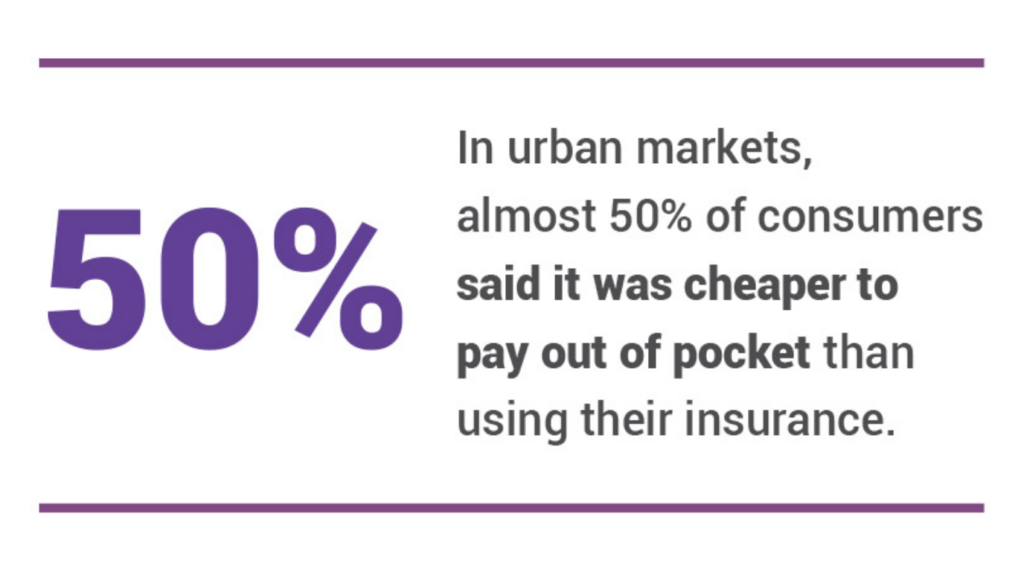
Meanwhile, races to the bottom for pricing— even outside of discount cards—further erode profits, leaving independent pharmacies with few options if they cannot absorb drugs sold at a loss. A majority recognize this: 73% of pharmacy decision makers say they try to offer the most commonly prescribed drugs at a reasonable price, but not the lowest, and only 16% say they try to offer the lowest price possible. Virtually all pharmacists (93%) believe they offer competitive prices.
Still, finding a sustainable cash pricing model is taking pharmacies more time than in the past. Independent pharmacies are spending a growing amount of energy on reviewing drug pricing while they are already strained with paperwork, compliance challenges, and operational inefficiencies. More than half of respondents (55%) said they spend 2-6 hours reviewing drug prices weekly, and 42% said they spend more time each week than they did two years ago.

I would gladly pay a bit more to help support my local independent pharmacy.
Consumer Respondent
Regardless of how they pay, patients are overall loyal to their independent pharmacies when they learn about the potential harm popular discount cards can bring. Although 69% of consumers said they were not fully aware that certain discount cards may be harmful to pharmacies (due to high fees), 75% of patients said they would be willing to pay slightly more for a drug by using a discount program that did not harm or negatively impact their pharmacy.
This shows consumers are more inclined to prefer “pharmacy-friendly” options when they are educated about the negative impacts of cash discount programs. Additionally, 88% of consumers said they would be willing to switch discount card programs if the discount card company was selling their personal data, even if it meant paying slightly more.
Finding the theoretical sweet spot between competitive pricing, profitability, and administrative time spent reviewing costs presents a major challenge to pharmacies today and will become more difficult in the coming years.
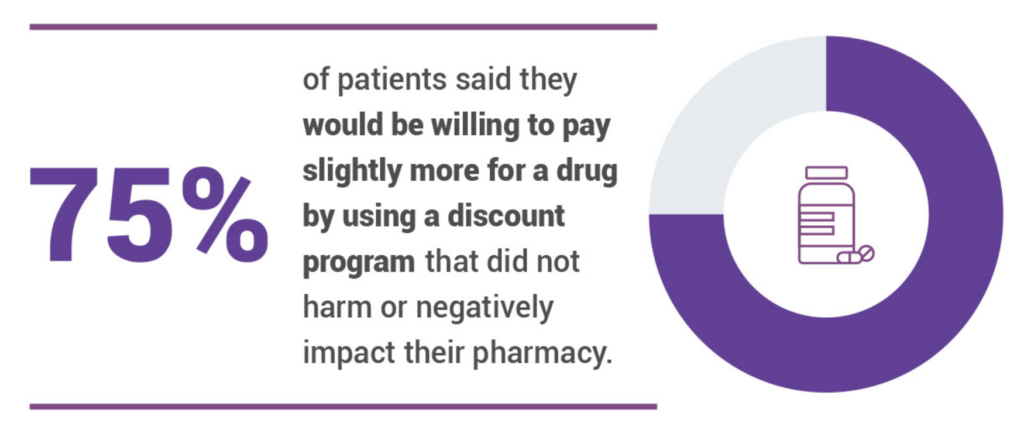
A convenient, technology-driven cash discount solution could greatly strengthen independent pharmacies’ financial position while delivering on consumer demands.
How pharmacy decision makers and consumers view the future
With local, independent pharmacies facing numerous immediate struggles, it will be critical for them to align with consumer wants and needs to retain and increase business.
As part of our survey, both pharmacy decision makers and consumers were asked about the top three categories that will set independent pharmacies apart in the next two years
The responses largely aligned, but there were significant differences in some key categories, suggesting many pharmacies should consider adjustments to their priorities to retain their customers as trends continue to shift.
Notably, 77% of pharmacy decision makers believe customer service is a top-three priority, while just 61% of consumers chose that as a top priority. Meanwhile, just 33% of pharmacists said convenience is one of their most valued aspects, while 63% of consumers said the same.
There was likewise a significant gap in the importance of flexibility, clinical services, and cost. More than 25% of decision makers said flexibility would be a top aspect in the next two years, against 16% of consumers; 26% of decision makers said offering clinical services would set them apart versus 11% of consumers; and 23% of decision makers said low costs would set them apart, versus 36% of consumers.
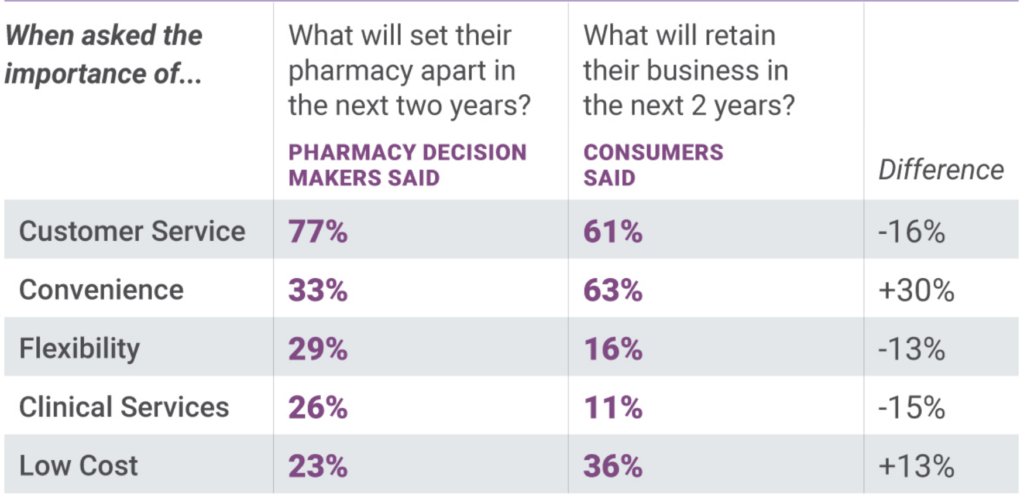
Attitudes between both decision makers and consumers pointed toward a heightened emphasis on technology to retain business in the coming years, providing further insight into the rising trends of consumerism and technology in pharmacy.
Among decision makers, 86% believe technology that enhances the patient experience will become an increasingly important differentiator for their pharmacy in the next 1-2 years. Consumers place a similar premium on technology: 91% of consumers said their independent pharmacy would be more likely to retain their business if that pharmacy adopts technology that enhances their experience.
Virtually all pharmacy decision makers (93%) said they believe pharmacists will play a bigger role in serving their community’s healthcare needs in the next 1-2 years. While clinical services may not be viewed as a top differentiator among consumers, it is valued as a clear retention driver, as 53% of patients said they expect their pharmacy to provide clinical services to retain their business.

Prescryptive’s perspective
Pharmacy decision makers can ensure their business can adapt and continue to service their patients by being proactive and responding to market forces.
With each challenge comes an opportunity on the path to improved growth and prosperity.
Traditional cash discount programs often carry high fees that cause profit loss, and attempts to provide in-house cash discounts can prove to be inconsistent and time-consuming for independent pharmacies that are drowning in administrative duties.
At the same time, consumers crave more convenient, empowering, and transparent technology for their pharmacy experience. They expressed some differences in what they consider near-future top priorities for their pharmacies versus what decision makers identified as differentiators.
Patients, however, feel a strong sense of loyalty to their independent pharmacies. An overwhelming majority would be willing to pay slightly more for their medications if it meant the solution was more “pharmacy-friendly.”

Consumer sentiments coupled with a desire for technological investments suggest a clear path to profitability for pharmacies that embrace technology-driven cash discount solutions while allowing consumers to transparently view prices before they reach the pharmacy counter. And with 40% of decision makers admitting they do not currently utilize technology to its fullest potential, the opportunities are massive for the independent pharmacy industry to reassert itself as an integral part to communities.
Throughout the COVID-19 pandemic, consumers increasingly turned to their pharmacies for all-encompassing health needs, demonstrating a major window of opportunity for pharmacies that expand their clinical services. While expanding clinical services requires new infrastructure such as increased scheduling, paperwork, and staffing, new technology can help reduce the burden.
The challenges facing independent pharmacies are great, but the opportunities for innovation are even greater. For independent pharmacies that truly embrace modern technology to meet consumers’ needs, the future is promising.
1 “What Was, Is No More: Community Pharmacy Economics.” Journal of Managed Care & Specialty Pharmacy. June 2020.
2 Levine, David M. et al. “Characteristics of Americans With Primary Care and Changes Over Time, 2002-2015.” JAMA Internal Medicine. Dec. 16, 2019.
³ National Center for Health Statistics. Health, United States, 2019: Table 39. Hyattsville, MD. 2021. Available from: https://www.cdc.gov/nchs/hus/contents2019.htm.
4 Fein, Adam. “The GoodRx-Kroger Blowup: Spread Pricing, Pharmacy Margins, and the Future of Discount Cards.” Drug Channels. May 24, 2022.
5 Brodie, Mollyann. “Public Opinion on Prescription Drugs and Their Prices.” Kaiser Family Foundation. April 5, 2022.
6 “2021 Healthcare in America Report.” West Health-Gallup. March 12, 2020.